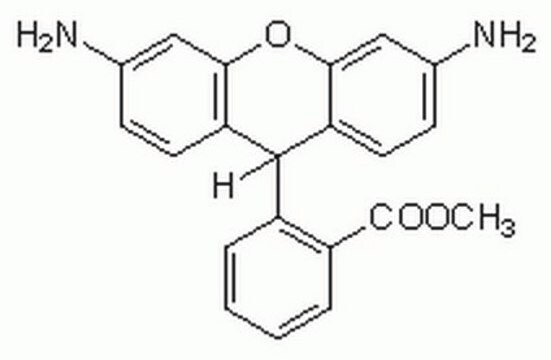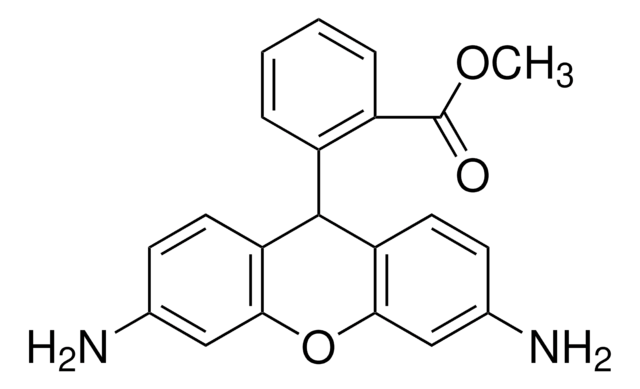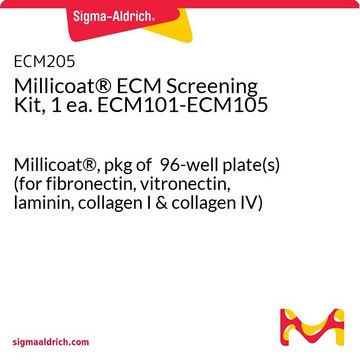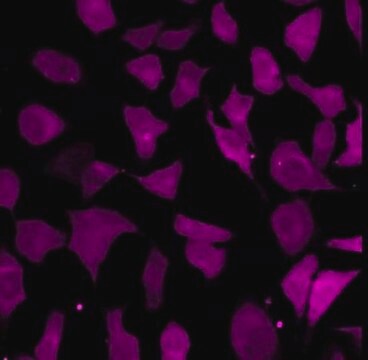ECM910
MDR1 Efflux Assay
The Multidrug Resistance Direct Dye Efflux Assay Kit includes two of the best characterized & most commonly used multidrug resistance ABC transporter substrates, DiOC2(3) & rhodamine 123.
Zaloguj sięWyświetlanie cen organizacyjnych i kontraktowych
About This Item
Kod UNSPSC:
12161503
eCl@ss:
32161000
NACRES:
NA.84
Polecane produkty
Poziom jakości
reaktywność gatunkowa (przewidywana na podstawie homologii)
mammals
producent / nazwa handlowa
Chemicon®
metody
cell based assay: suitable
numer dostępu NCBI
numer dostępu UniProt
metoda wykrywania
fluorometric
Zastosowanie
Research Category
Cell Structure
Cell Structure
The Multidrug Resistance Direct Dye Efflux Activity Kit is designed to directly measure the functional activity of MDR1, MRP1 and BCRP by assaying for the ability of the cell to extrude fluorescent transport substrates of these proteins. The kit can be used to measure relative amounts of MDR1, MRP and BCRP activity between different cell populations. In addition, dye efflux assays can be used to assess the ability of unlabeled small molecules to serve as transport substrates for MDR1, MRP1 and BCRP and the ability of candidate inhibitors to block the function of these proteins.
Two conveniently formulated solutions of MDR1, MRP1 and BCRP substrate dyes, DiOC2(3) Solution and Rhodamine 123 Solution, are included in the kit to give the investigator flexibility in the substrate specificity of the efflux probe. In addition, a solution of a nonfluorescent substrate of MDR1 and MRP1, Vinblastine Solution, is provided to serve as a competitive inhibitor of dye efflux. DMSO is included as a diluent control for the Vinblastine Solution. Sterile, concentrated RPMI-1640 and BSA are provided as components for buffer for the loading, efflux and washing steps of the procedure. A sterile, concentrated solution of gentamicin, which has been shown to not be a substrate for MDR1 (Mechetner and Roninson, 1992), is supplied as an optional antibiotic for the buffer. Propidium iodide solution is included to identify dead cells and exclude them from the analysis.
The extent of efflux of fluorescent dyes is best analyzed by flow cytometry. The assay can also be incorporated with immunostaining experiments for multicolor analysis of cell surface marker expression and MDR1, MRP1 and BCRP function. Efflux mediated by MDR1, MRP1 and BCRP can also be quantified by analysis under a fluorescence microscope or on a fluorometric plate reader.
The efflux activity of MDR1 and its relatives is highly temperature sensitive. MDR1 functions optimally near 37ºC, but is effectively inactive at 4ºC. MDR1-expressing cells preloaded with MDR1 fluorescent substrates retain the dye and consequently have high fluorescence when incubated at 4ºC (Figure 1, 4ºC, top panels). Conversely, cells incubated at 37ºC more readily efflux the dye and show reduced fluorescence (Figure 1, 37ºC + DMSO, middle panels). The kit also includes a specific inhibitor vinblastine, which is also a substrate for MDR1 and competitively blocks efflux of DiOC2(3) and Rhodamine 123. Inclusion of excess vinblastine in the efflux reaction at 37ºC therefore results in high fluorescence (Figure 1, 37ºC + vinblastine, bottom panels).
For Research Use Only; Not for use in diagnostic or in vivo procedures
Two conveniently formulated solutions of MDR1, MRP1 and BCRP substrate dyes, DiOC2(3) Solution and Rhodamine 123 Solution, are included in the kit to give the investigator flexibility in the substrate specificity of the efflux probe. In addition, a solution of a nonfluorescent substrate of MDR1 and MRP1, Vinblastine Solution, is provided to serve as a competitive inhibitor of dye efflux. DMSO is included as a diluent control for the Vinblastine Solution. Sterile, concentrated RPMI-1640 and BSA are provided as components for buffer for the loading, efflux and washing steps of the procedure. A sterile, concentrated solution of gentamicin, which has been shown to not be a substrate for MDR1 (Mechetner and Roninson, 1992), is supplied as an optional antibiotic for the buffer. Propidium iodide solution is included to identify dead cells and exclude them from the analysis.
The extent of efflux of fluorescent dyes is best analyzed by flow cytometry. The assay can also be incorporated with immunostaining experiments for multicolor analysis of cell surface marker expression and MDR1, MRP1 and BCRP function. Efflux mediated by MDR1, MRP1 and BCRP can also be quantified by analysis under a fluorescence microscope or on a fluorometric plate reader.
The efflux activity of MDR1 and its relatives is highly temperature sensitive. MDR1 functions optimally near 37ºC, but is effectively inactive at 4ºC. MDR1-expressing cells preloaded with MDR1 fluorescent substrates retain the dye and consequently have high fluorescence when incubated at 4ºC (Figure 1, 4ºC, top panels). Conversely, cells incubated at 37ºC more readily efflux the dye and show reduced fluorescence (Figure 1, 37ºC + DMSO, middle panels). The kit also includes a specific inhibitor vinblastine, which is also a substrate for MDR1 and competitively blocks efflux of DiOC2(3) and Rhodamine 123. Inclusion of excess vinblastine in the efflux reaction at 37ºC therefore results in high fluorescence (Figure 1, 37ºC + vinblastine, bottom panels).
For Research Use Only; Not for use in diagnostic or in vivo procedures
The Multidrug Resistance Direct Dye Efflux Assay Kit includes two of the best characterized & most commonly used multidrug resistance ABC transporter substrates, DiOC2(3) & rhodamine 123.
Komponenty
Sterile 5x RPMI-1640 (Part No. 90302) - One bottle containing 200 ml of sterile 5x concentrated RPMI-1640.
Sterile 30% BSA (Part No. 90303) - One bottle containing 35 ml sterile-filtered 30% bovine serum albumin (BSA) in PBS.
Gentamicin Solution, 1000x (Part No. 90353) - One vial containing 1 ml sterile-filtered 50 mg/ml gentamicin.
DiOC2(3) Solution (Part No. 90299) - One vial containing 50 μl of DiOC2(3) (3,3′-diethyloxacarbocyanine iodide) at 1 mg/ml in DMSO.
Rhodamine 123 Solution (Part No. 90300) - One vial containing 0.5 ml of rhodamine 123 at 1 mg/ml in DMSO.
Vinblastine Solution (Part No. 90301) - One vial containing 150 μl of 22 mM vinblastine in DMSO.
DMSO (Part No. 90294) - One vial containing 150 μl DMSO.
Propidium Iodide Stock Solution (Part No. 90296) - One vial containing 1 ml of 50 μg/ml propidium iodide in PBS.
Sterile 30% BSA (Part No. 90303) - One bottle containing 35 ml sterile-filtered 30% bovine serum albumin (BSA) in PBS.
Gentamicin Solution, 1000x (Part No. 90353) - One vial containing 1 ml sterile-filtered 50 mg/ml gentamicin.
DiOC2(3) Solution (Part No. 90299) - One vial containing 50 μl of DiOC2(3) (3,3′-diethyloxacarbocyanine iodide) at 1 mg/ml in DMSO.
Rhodamine 123 Solution (Part No. 90300) - One vial containing 0.5 ml of rhodamine 123 at 1 mg/ml in DMSO.
Vinblastine Solution (Part No. 90301) - One vial containing 150 μl of 22 mM vinblastine in DMSO.
DMSO (Part No. 90294) - One vial containing 150 μl DMSO.
Propidium Iodide Stock Solution (Part No. 90296) - One vial containing 1 ml of 50 μg/ml propidium iodide in PBS.
Przechowywanie i stabilność
Kit components should be stored at 2-8°C upon arrival. Product is stable for 1 year after receipt. DiOC2(3) Solution, Rhodamine 123 Solution, Vinblastine Solution, and DMSO will freeze at 2-8°C, and can be thawed and refrozen at least 5 times. Protect DiOC2(3), Rhodamine 123 and Propidium Iodide Solutions from light.
Precautions
Propidium Iodide, Gentamicin, Vinblastine, Rhodamine 123 and DiOC2(3) may have toxic effects if handled improperly. DMSO is absorbed through the skin and can facilitate internalization of toxic agents. Use caution when handling each of these components. Standard precautions include wearing gloves and a lab coat.
Precautions
Propidium Iodide, Gentamicin, Vinblastine, Rhodamine 123 and DiOC2(3) may have toxic effects if handled improperly. DMSO is absorbed through the skin and can facilitate internalization of toxic agents. Use caution when handling each of these components. Standard precautions include wearing gloves and a lab coat.
Informacje prawne
CHEMICON is a registered trademark of Merck KGaA, Darmstadt, Germany
Oświadczenie o zrzeczeniu się odpowiedzialności
Unless otherwise stated in our catalog or other company documentation accompanying the product(s), our products are intended for research use only and are not to be used for any other purpose, which includes but is not limited to, unauthorized commercial uses, in vitro diagnostic uses, ex vivo or in vivo therapeutic uses or any type of consumption or application to humans or animals.
Ta strona może zawierać tekst przetłumaczony maszynowo.
Hasło ostrzegawcze
Danger
Zwroty wskazujące rodzaj zagrożenia
Zwroty wskazujące środki ostrożności
Klasyfikacja zagrożeń
Muta. 2 - Resp. Sens. 1 - Skin Sens. 1
Kod klasy składowania
10 - Combustible liquids
Temperatura zapłonu (°F)
188.6 °F
Temperatura zapłonu (°C)
87 °C
Certyfikaty analizy (CoA)
Poszukaj Certyfikaty analizy (CoA), wpisując numer partii/serii produktów. Numery serii i partii można znaleźć na etykiecie produktu po słowach „seria” lub „partia”.
Masz już ten produkt?
Dokumenty związane z niedawno zakupionymi produktami zostały zamieszczone w Bibliotece dokumentów.
Parveen Abidi et al.
Journal of lipid research, 47(10), 2134-2147 (2006-08-04)
Our previous studies have identified berberine (BBR), an alkaloid isolated from the Chinese herb huanglian, as a unique cholesterol-lowering drug that upregulates hepatic low density lipoprotein receptor (LDLR) expression through a mechanism of mRNA stabilization. Here, we demonstrate that the
Magdalena Kasendra et al.
eLife, 9 (2020-01-15)
Induction of intestinal drug metabolizing enzymes can complicate the development of new drugs, owing to the potential to cause drug-drug interactions (DDIs) leading to changes in pharmacokinetics, safety and efficacy. The development of a human-relevant model of the adult intestine
Gad D Vatine et al.
Cell stem cell, 24(6), 995-1005 (2019-06-08)
The blood-brain barrier (BBB) tightly regulates the entry of solutes from blood into the brain and is disrupted in several neurological diseases. Using Organ-Chip technology, we created an entirely human BBB-Chip with induced pluripotent stem cell (iPSC)-derived brain microvascular endothelial-like cells
Nasz zespół naukowców ma doświadczenie we wszystkich obszarach badań, w tym w naukach przyrodniczych, materiałoznawstwie, syntezie chemicznej, chromatografii, analityce i wielu innych dziedzinach.
Skontaktuj się z zespołem ds. pomocy technicznej







